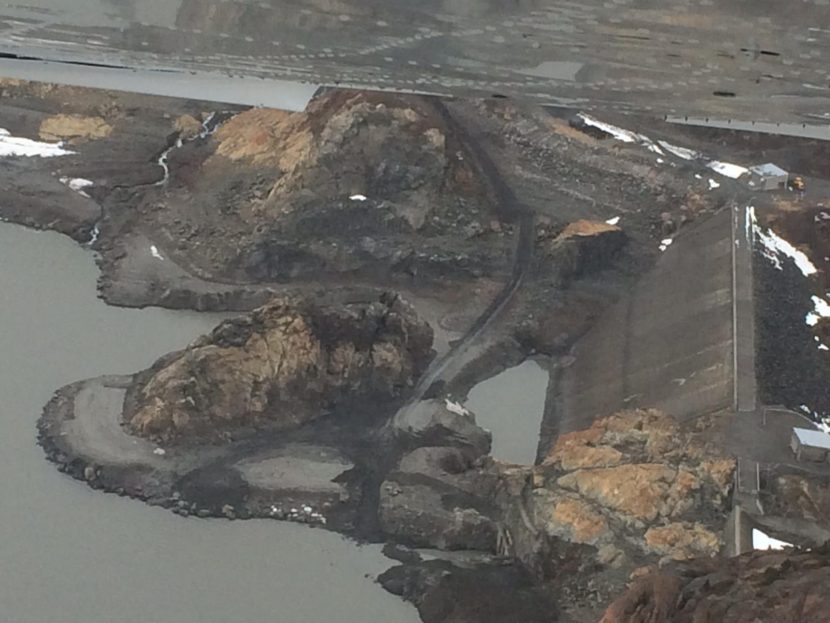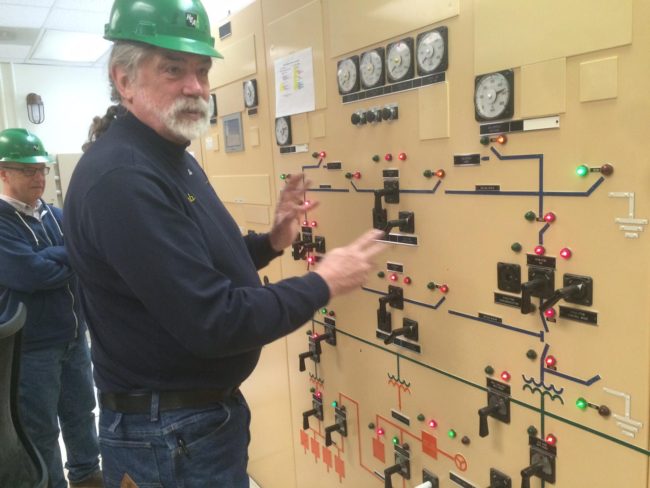
About 27 miles northeast of Homer, there is a hydroelectric project in its infancy. The plant, which hadn’t changed much since its construction, just saw the completion of a major project and another one could get underway in a few years.
The Bradley Lake Hydroelectric project is at the head of Kachemak Bay. The basic idea was to dam Bradley Lake and feed its water into turbines that generate electricity.
Not all of the lake’s water goes into the turbines, though. Some is diverted into the Lower Bradley River, which flows into Kachemak Bay. The plant is required to keep water flowing into the river to, as Bob Day puts it, “keep the fish happy.”
“And so if we get a lot of rain over in that basin then we don’t have to release fish water and we shut it down. If we don’t get rain we open it up. What we found is that the valves were clogged up. There was a bunch of rock and mud and debris that over the years had fallen down over the intake,” said Day.
Day is a power production manager for Homer Electric Association. He recently drove a tour group up to see the dam.

The dam is 600 feet long and 125 feet high. It is a rock filled concrete wall that sits in stark contrast to the Bradley Lake overshadowed by snowy mountain peaks. The only access is a switch back road that gradually climbs from the beach to the mountains.
Day said they found the blockage 2 or 3 years ago and it put them out of compliance with state regulation.
“We came up with this big plan to use all the energy in the lake by running the plant really hard, which we’ve done the last couple of months,” said Day.
They used enough water between October and April to drop the lake level by about 122 feet so they could clear the blockage. Day said that put the water level where it was before the dam was built. They are depending on rainfall, snow melt and glacier runoff to refill it. Progress is slow and until the lake is full again, the plant can’t run at full capacity.
Hydropower projects like Bradley are popular because the energy is considered clean, relatively cheap and, if managed correctly, it lasts for a very long time. Some of the earliest hydroelectric plants built in the late 1800s are still in operation.
The downside is it’s hard to find tons of water to generate electricity that isn’t needed by fish or wildlife.
“You need a big river if you’re going to make a hydroplant, so where would it be? Well you can’t touch the Kasilof, can’t touch the Kenai, can’t touch any salmon streams really. So you end up with very, very few sites,” said Day.
Day said there aren’t any fish in Bradley Lake, but it’s one of a few exceptions. According to Homer Electric Association, Bradley is the largest of seven hydroprojects in the state.
Construction of the Bradley Lake Hydroelectric Project started in the late ’80s and the plant was generating power by the fall of 1991.
About 10 percent of the electricity distributed between the Kenai Peninsula and on up to Fairbanks comes from Bradley Lake.
Bradley puts out around 380,000 megawatt-hours of power per year.
“Megawatt-hour is a thousand kilowatt-hours. At most people’s home, their bill comes 590 – 650 kilowatt-hours in a month,” said Day.
Day gets lost in the math for a minute, but eventually said a year’s worth of power from Bradley could power 600,000 homes for a month.
The project is owned by the state through the Alaska Energy Authority and is operated under a cooperative of six utilities that each get a share of the power the plant produces. Homer Electric Association takes a share and runs the day-to-day operations of the plant.
They’re waiting for the go ahead to tackle their next big project called the Battle Creek Diversion. Battle Creek is a stream of water that flows down a mountain from a nearby glacier. The diversion would send some of the glacier runoff into Bradley Lake.
“Which could represent a pretty substantial … about a 10 to 20 percent increase to the amount of energy Bradley could produce every year,” said Day.
Whether that project moves forward depends on state and federal authorities’ approval.
“It’s going to change the nature of the water that gets into Kachemak Bay slightly, so there’s been a lot of discussion over what does that mean and how does that affect the fishery,” said Day.
According to the Alaska Energy Authority, the Federal Energy Regulatory Commission just finished a draft environmental assessment of the project in March.
A final environmental assessment is expected to be released later this year.
If the project is deemed safe, Day estimates they could start work on Battle Creek next year.
For now, they’re waiting on Bradley Lake to fill up so they can get the plant running back at full capacity. Day said the lake has gone up 8 feet since the middle of April. They’ve got 104 feet left to go.
